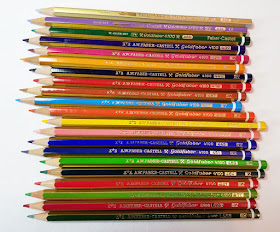 |
| Vintage Goldfaber water-soluble colored pencils |
In my review of vintage Prismacolor pencils, I had mentioned that pencils of this brand produced in the ‘90s
and earlier are of higher quality than ones you can buy now because they are no
longer manufactured in the U.S. As a result, Prismacolors with early production
dates are highly sought on eBay by colored pencil artists. I’ve acquired some from
that early U.S.-manufacturing era, and they certainly are as creamy and richly
pigmented as contemporary ones – but without the annoying core-breakage issue
that newer ones are known for. (I threw out a set a few years ago because the
continual breakage drove me crazy.)
I hang out a lot in the analog-centric world (on the
Internet, ironically), where people sometimes get wrapped up in discussions
about how everything back in the day was better made than anything made now. Whether
they are influenced by personal nostalgia for the good ol’ days or unbiased research
is difficult to say. Although it’s certainly true of many products (especially
appliances – it seems like whenever we have to replace a fridge or washer, the
newer one doesn’t last nearly as long as the one it replaced), it’s not
universally true, by any means.
My experience with the Prismacolors and the general “older
is better” attitude have been on my mind, and I started wondering if the same
could be true of other colored pencil brands. The difficulty, however, is in finding
both a vintage set and a contemporary set of the same brand, since so many
vintage brands are no longer being produced.
Coincidentally, an example of old and new came to my
attention at around the same time. On one of my cruises through eBay, I had
spotted some vintage German-made Faber-Castell Goldfaber water-soluble colored
pencils. I had never heard the brand Goldfaber before, but shortly thereafter,
I found a "new" Faber-Castell Goldfaber brand on the market (which I reviewed last month). Since the contemporary ones are also German-made, I had
a rare apples-to-apples situation.
The small collection I purchased on eBay included several
different ages of the brand, as represented by their designs and markings. A
small group has a dark blue barrel with a distinctively long end cap indicating
the color (below). The cores on these are slightly softer than on the pencils in the
larger group, whose hex facets alternate between metallic gold and the core
color (top of page). Although the vendor didn’t know specific production years, he said the dark
blue ones are newer. He also reassured me that they are all German-made. (His
actual words: “The ones I sell are all vintage, no longer in production, good
old German stuff!”)
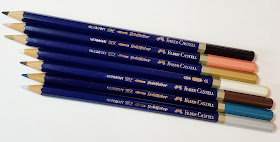 |
| The newest of the vintage Goldfabers |
In addition, the gold-faceted pencils show several variations
of the logo and branding. The design of the top two looks the most modern and
includes the paint brush icon. Although all are water-soluble, the gold-faceted ones do not show the paint brush icon.
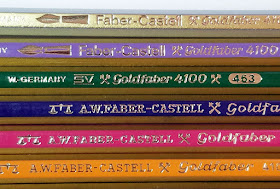 |
| Variations in branding |
I preferred swatching the softer cores of the dark blue collection,
but the colors I needed for my apple sketch were in the older gold-faceted
group. Compared to the contemporary Goldfaber set I reviewed earlier (the
same sketch you saw previously is shown again here for reference), the vintage
pencils are much harder and difficult to layer and blend. I spent the same
amount of time on each sketch (35 minutes), but as you can see, I couldn’t get rich
hues with the vintage pencils. At the point that I stopped, I had applied enough
layers in my usual method (repeatedly alternating applications of dry pencil,
activating with water, and allowing it to dry) that the paper couldn’t take
much more.
 |
| 6/4/18 vintage Goldfaber water-soluble colored pencils in Stillman & Birn Beta sketchbook |
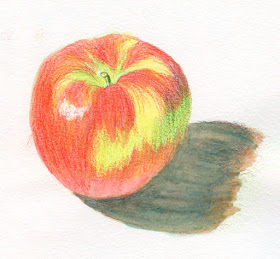 |
| 5/16/18 contemporary Goldfaber Aqua pencils in S & B Beta sketchbook |
My conclusion: Old is not necessarily better, at least in function.
I’m sure manufacturing processes have improved over time, making it cheaper and
more efficient to produce pencils. I imagine that a long-standing company like
Faber-Castell still takes pride in developing better products and using high quality
materials. And in recalling my Prismacolor experience, perhaps the most
important factor is that F-C has maintained production in Germany instead of
cutting costs in other countries.
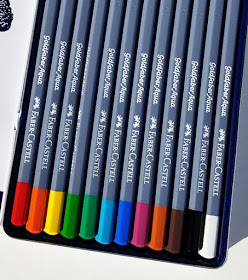 |
| Contemporary Goldfaber Aqua |
I must say, though, that the older designs are more attractive
than the contemporary Goldfaber design, which seems perfunctory at best. It’s
just a pencil, but more care seems to have been taken with giving it a
distinctive look. This might be one of those nostalgia-based views, but at
least in this case, older looks
better.






















































